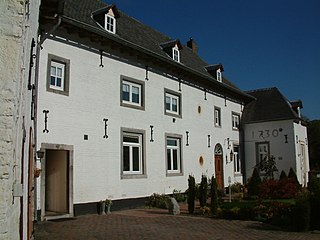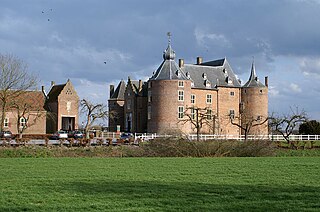
Spaubeek is a village in the Dutch province of Limburg. It is located in the municipality of Beek, about 3 km south of the town of Geleen. Spaubeek was a separate municipality until 1982, when it was merged with Beek.

Vredenburg Castle was a 16th-century castle built by Habsburg emperor Charles V in the city of Utrecht in the Netherlands. Some remains of the castle, which stood for only 50 years, are still visible on what is now Vredenburg square in Utrecht.

Beersel Castle is a medieval castle located in Beersel, Flemish Brabant, Belgium. Originating in 1300 under the auspices of the Duchy of Brabant, the water castle's present configuration dates to 1357. It was twice sacked and was subject to significant restorations in 1491 and 1617. Its present condition owes much to a major restoration in 1928–39. Built largely of brick, a rare material for such buildings at the time, around a circular enceinte, its major feature is its three large towers. Nowadays, it is open to the public and is considered one of Belgium's best-preserved castles.

Loenersloot is a village in the Dutch province of Utrecht. It was a part of the former municipality of Loenen. Since 2011 it has made part of the new formed municipality of Stichtse Vecht. It lies about 12 km west of Hilversum. It is located on the Angstel River.

Heeswijk Castle is a moated castle near Heeswijk in the Dutch province of North Brabant.

Kota Tua Jakarta, officially known as Kota Tua, is a neighborhood comprising the original downtown area of Jakarta, Indonesia. It is also known as Oud Batavia, Benedenstad, or Kota Lama.

Jansgeleen Castle, now erroneously called Sint-Jansgeleen or Sint Jansgeleen, was a medieval castle in the little village of Spaubeek, in the Dutch province of Limburg. Spaubeek is located in the municipality of Beek, about 3 km south of the town of Geleen. Spaubeek was a separate municipality until 1982, when it was merged with Beek.

Dorkwerd is a small village in Groningen, the Netherlands. It is located in the municipality of Groningen, about 4 km northwest of the city center. Recent construction of new residential areas have brought the city to less than 500 meters from the village of Dorkwerd, and the postal authorities have placed it under Groningen.

Bleijenbeek is a small hamlet in the Dutch province of Limburg. It is located in the municipality of Bergen, about 2 km east of Afferden.

Anholt is a hamlet in northeast Netherlands. It is located in the municipality De Wolden, Drenthe, about 2 km west of Pesse.
Bahr is a hamlet in the Dutch province of Gelderland. It is located in the municipality Zevenaar, about 3 km southeast of Rheden.
Baalhoek is a hamlet in the Dutch province of Zeeland. It is located in the municipality of Hulst, about 5 km east of Kloosterzande on the dyke of the Westerschelde.

Belt-Schutsloot is a village in the Dutch province of Overijssel. It is located in the municipality of Steenwijkerland, about 3 km north of Zwartsluis.

Bern is a hamlet in the Dutch province of Gelderland. It is located in the municipality of Zaltbommel, about 10 kilometres south of the town Zaltbommel.
Bosch is a hamlet in the Dutch province of North Brabant. It is located in the municipality of Cranendonck, about 1.5 km east of Budel.
Heikant is a hamlet in the Dutch province of North Brabant. It is located in the municipality of Cranendonck, about 1.5 km southeast of Budel.
Pothuizen is a former village in the Dutch province of Utrecht. It was located on the Lek river north of Culemborg, and stretched along the Lek dike on both sides of the Schalkwijkse Wetering.

Ammersoyen Castle is located in Ammerzoden in the Bommelerwaard region in the province of Gelderland, the Netherlands. When the original construction of the castle occurred is unclear; some sources claim it was as early as the 12th century. However, the consensus among historians is that the Van Herlaer family completed the castle in the 1350s. At the time of its construction, the castle was built along a branch of the river Maas. Just a few years after the construction of the castle was completed, the river was rerouted leaving the castle to be surrounded by a moat.

Heusden Castle is a ruined major castle in Heusden.
















